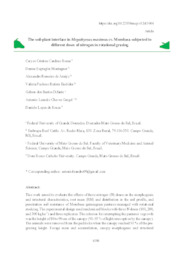The soil-plant interface in Megathyrsus maximus cv. Mombasa subjected to different doses of nitrogen in rotational grazing.
The soil-plant interface in Megathyrsus maximus cv. Mombasa subjected to different doses of nitrogen in rotational grazing.
Autoria: SOUSA, C. C. C.; MONTAGNER, D. B.; ARAUJO, A. R. de; EUCLIDES, V. P. B.; DIFANTE, G. dos S.; GURGEL, A. L. C.; SOUZA, D. L. de
Resumo: ABSTRACT - This work aimed to evaluate the effects of three nitrogen (N) doses on the morphogenic and structural characteristics, root mass (RM) and distribution in the soil profile, and penetration soil resistance of Mombasa guineagrass pastures managed with rotational stocking. The experimental design used randomized blocks with three N doses (100, 200, and 300 kg ha-¹) and three replicates. The criterion for interrupting the pastures' regrowth was the height of 80 to 90 cm of the canopy (90-95 % of light interception by the canopy). The animals were removed from the paddocks when the canopy reached 50 % of the pre-grazing height. Forage mass and accumulation, canopy morphogenic and structural characteristics, RM and distribution in the soil profile, and soil resistance to penetration were evaluated. In pastures fertilized with 200 and 300 kg ha-¹ of N, the highest leaf appearance (0.090 and 0.081 leaves-¹ tiller-¹ d -¹ ), elongation rates (2.82 and 2.61 cm tiller-¹ d -¹ ) and highest daily forage accumulation (113.8 and 106.6 kg ha-¹ d-¹ ) were observed. Using 300 kg ha-¹ of N promoted greater soil resistance to penetration at 10 cm of depth in the post-grazing (3.3 MPa). No effect of N doses was observed for RM (P>0.05). The pre- and post-grazing height control of animals in the paddocks therefore helped to maintain the pasture structure and avoid the soil compaction process. According to the results, it is concluded that 200 and 300 kg ha-¹ of N fertilization is a strategy for intensifying pastures.
Ano de publicação: 2021
Tipo de publicação: Artigo de periódico
Unidade: Embrapa Gado de Corte
Palavras-chave: Nitrogênio, Pastagem, Pastejo Rotativo
Observações
1 - Por padrão são exibidas publicações dos últimos 20 anos. Para encontrar publicações mais antigas, configure o filtro ano de publicação, colocando o ano a partir do qual você deseja encontrar publicações. O filtro está na coluna da esquerda na busca acima.
2 - Para ler algumas publicações da Embrapa (apenas as que estão em formato ePub), é necessário ter, no celular ou computador, um desses softwares gratuitos. Sistemas Android: Google Play Livros; IOS: iBooks; Windows e Linux: software Calibre.
Acesse outras publicações
Acesse a Base de Dados da Pesquisa Agropecuária (BDPA) para consultar o acervo completo das bibliotecas da Embrapa.

